Do you have a question about the Cisco Nexus 3548 series and is the answer not in the manual?
Defines the target audience for the publication, typically network administrators.
Explains conventions used for commands, arguments, and syntax in the document.
Provides guidance on how to get Cisco documentation and submit service requests.
Instructs users on how to provide feedback or report errors in the document.
Lists other relevant Cisco Nexus 3000 Series documentation.
Provides an overview of significant changes and new features in the current release of the guide.
Describes the system management features documented in the guide, including Active Buffer Monitoring, Warp Mode, User Accounts and RBAC, and Session Manager.
Introduces PTP as a time synchronization protocol and its benefits over NTP.
Details common PTP device types: Ordinary, Boundary, and Transparent clocks.
Explains the two phases of the PTP process: master-slave hierarchy establishment and clock synchronization.
States that stateful restarts are not supported for PTP.
Specifies that PTP requires no license and is bundled with Cisco NX-OS.
Lists configuration guidelines and limitations for PTP, including supported modes and protocols.
Presents a table of default PTP parameters.
Provides steps to configure PTP globally, including enabling the feature and setting source IP addresses.
Introduces system message logging for controlling message destinations and severity levels.
States that system message logging requires no license.
Mentions that system messages are logged to the console and logfile by default.
Lists default parameters for system message logging, such as console and log file logging.
Details how to configure system message logging to terminal sessions and log files.
Explains how to enable and disable transceiver digital optical monitoring (DOM) logging.
Lists commands to verify system message logging configuration.
Describes Smart Call Home as a feature for notifying about critical system events via email.
Outlines guidelines and limitations for using the Smart Call Home feature.
Lists the necessary prerequisites for configuring Smart Call Home.
Presents default parameters for Call Home, including message size and SMTP port.
Guides through registering for Smart Call Home and configuring contact information.
Provides commands to verify the Smart Call Home configuration.
Shows a sample full-text format for a syslog alert notification.
Displays a sample XML format for a syslog alert notification.
Explains Session Manager for implementing configuration changes in batch mode.
Lists guidelines and limitations for Session Manager, including ACL support and command limits.
Provides steps to create a session, configure ACLs, verify, commit, save, and discard sessions.
Lists commands to verify Session Manager configuration information.
Introduces the scheduler for defining and setting timetables for maintenance activities.
States that the scheduler feature does not require a license.
Lists guidelines and limitations for the scheduler, including potential failure conditions.
Presents default parameters for the scheduler, such as scheduler state and log file size.
Guides through enabling the scheduler, defining log file size, and configuring remote user authentication.
Lists commands to verify the scheduler configuration.
Provides examples for creating, scheduling, and displaying scheduler jobs and their results.
States that no new or modified standards are supported by the scheduler feature.
Introduces SNMP as an application-layer protocol for network device monitoring and management.
Specifies that SNMP requires no license and is bundled with Cisco NX-OS.
Lists guidelines and limitations for SNMP, including MIB support and security levels.
Presents default SNMP parameters, such as license notifications and link status notification type.
Details how to configure SNMP users, communities, message encryption, and access.
Provides steps to disable SNMP on the device.
Lists commands to verify the SNMP configuration.
Introduces RMON as an IETF standard for network monitoring, supporting alarms, events, and logs.
Lists guidelines and limitations for RMON, including SNMP user and notification receiver requirements.
Details how to configure RMON alarms and events.
Lists commands to verify the RMON configuration.
Presents default settings for RMON parameters, indicating no alarms or events are configured by default.
Explains online diagnostics for hardware verification during bootup or reset and health monitoring.
Guides on configuring bootup diagnostics level to complete or bypass tests.
Lists commands to verify online diagnostics configuration.
Presents default settings for online diagnostics, with bootup diagnostics level set to complete.
Introduces Embedded Event Manager (EEM) for detecting and handling critical events for high availability.
Explains EEM policies consist of event and action statements, and covers preconfigured and user-created policies.
Specifies that EEM requires no license and is bundled with Cisco NX-OS.
States that network-admin privileges are required to configure EEM.
Shows default settings for EEM, with System Policies active.
Describes defining environment variables as an optional step for configuring common values.
Provides steps to define a user policy using the CLI, including registering applets.
Guides on configuring event statements for EEM policies, covering various event types.
Details how to configure action statements for EEM policies, including CLI commands and syslog messages.
Explains how to write EEM policies using VSH scripts.
Guides on registering and activating VSH script policies.
Explains how to override system policies in EEM.
Details how to configure syslog as an EEM publisher to monitor syslog messages from the switch.
Introduces SPAN (Switched Port Analyzer) for network traffic analysis using network analyzers.
Lists guidelines and limitations for SPAN.
Defines SPAN sources as interfaces from which traffic is monitored, supporting Ethernet, port channels, and VLANs.
Describes characteristics of source ports, including types, direction, and session limits.
Defines SPAN destinations as interfaces that monitor source ports, supporting Ethernet interfaces.
Describes characteristics of destination ports, including physical port requirements and exclusion rules.
Explains SPAN and ERSPAN filtering to monitor specific traffic flows and reduce packet drops.
Details SPAN and ERSPAN sampling to monitor a subset of packets and reduce bandwidth usage.
Describes SPAN and ERSPAN truncation to reduce packet size based on MTU.
Provides steps to create a SPAN session by assigning a session number.
Guides on configuring an Ethernet interface as a SPAN destination port.
Details how to configure source ports for SPAN sessions, supporting Ethernet ports.
Explains configuring port channels or VLANs as source ports for SPAN sessions.
Guides on providing a descriptive name for a SPAN session for ease of reference.
Provides steps to activate a SPAN session to duplicate packets from sources to destinations.
Explains how to suspend a SPAN session, which is shut by default.
Details configuring SPAN filters for local and ERSPAN-source sessions.
Guides on configuring sampling for local and ERSPAN-source sessions.
Explains how to configure truncation for local and ERSPAN-source sessions.
Lists commands to display SPAN session information.
Introduces ERSPAN (Encapsulated Remote Switching Port Analyzer) for mirroring traffic over an IP network.
Specifies that ERSPAN requires no license and is bundled with Cisco NX-OS.
States the prerequisite for ERSPAN, requiring Ethernet interface configuration.
Lists guidelines and limitations for ERSPAN, including supported traffic types and session limits.
Presents default settings for ERSPAN sessions, which are created in the shut state.
Guides on configuring ERSPAN source sessions, including global origin IP and granularity.
Provides examples for configuring ERSPAN source and destination sessions.
Lists related documents, such as the Cisco Nexus NX-OS System Management Command Reference.
Introduces Warp SPAN as an AlgoBoost feature for spanning traffic to multiple ports with low latency.
Lists guidelines and limitations for Warp SPAN, including port requirements and group configurations.
Guides on enabling Warp SPAN and configuring its destination groups.
Provides commands to verify the Warp SPAN mode configuration.
Indicates that Warp SPAN was introduced in release 5.0(3)A1(2).
Explains DNS client functionality for translating hostnames to IP addresses.
States the prerequisite for DNS clients: a DNS name server on the network.
Specifies that DNS requires no license and is bundled with Cisco NX-OS.
Presents default settings for DNS clients, with the DNS client enabled.
Guides on configuring DNS clients to use DNS servers, including static mappings and domain lookups.
Describes Warp Mode as a hardware-accelerated forwarding mechanism for reduced latency.
Lists guidelines and limitations for Warp Mode, including route table reduction and unsupported features.
Provides steps to enable or disable Warp Mode on the device.
Lists commands to verify Warp Mode status and TCAM sizes.
Indicates that Warp Mode was introduced in release 5.0(3)A1(1).
Introduces Active Buffer Monitoring for detecting network congestion using buffer occupancy data.
Guides on configuring active buffer monitoring for unicast or multicast traffic, including threshold and sampling.
Lists commands to display buffer histogram data, including summary and detailed information.
Defines Software Maintenance Upgrades (SMUs) as packages containing fixes for specific defects.
Outlines the general procedure for adding, activating, and committing SMU packages.
Lists prerequisites for SMU activation/deactivation, including user group and line card status.
Lists guidelines and limitations for SMUs, including package dependencies and compatibility.
Provides guidance on performing SMU upgrades, including preparation steps.
Details steps to prepare for SMU package installation using show commands.
Guides on copying SMU package files to local storage or network servers.
Provides steps to add and activate SMU packages on the device.
Explains how to commit the active package set to make activation persistent across reloads.
Details steps to deactivate and remove SMU packages.
Lists commands to display installation log information for operations.
Introduces the rollback feature for taking configuration snapshots and reapplying them.
Lists guidelines and limitations for rollbacks, including checkpoint limits and naming conventions.
Provides steps to create configuration checkpoints with optional descriptions.
Guides on implementing a rollback to a checkpoint name or file, including atomic rollbacks.
Lists commands to verify the rollback configuration.
Explains User Accounts and RBAC for defining user access levels based on roles and rules.
Lists guidelines and limitations for user accounts and RBAC, including password requirements and role assignments.
Provides steps to configure user accounts, including setting usernames, passwords, and roles.
Guides on creating user roles and rules, feature groups, and interface/VLAN policies.
Lists commands to verify user accounts and RBAC configuration.
Presents default settings for user accounts and RBAC parameters.
Defines the target audience for the publication, typically network administrators.
Explains conventions used for commands, arguments, and syntax in the document.
Provides guidance on how to get Cisco documentation and submit service requests.
Instructs users on how to provide feedback or report errors in the document.
Lists other relevant Cisco Nexus 3000 Series documentation.
Provides an overview of significant changes and new features in the current release of the guide.
Describes the system management features documented in the guide, including Active Buffer Monitoring, Warp Mode, User Accounts and RBAC, and Session Manager.
Introduces PTP as a time synchronization protocol and its benefits over NTP.
Details common PTP device types: Ordinary, Boundary, and Transparent clocks.
Explains the two phases of the PTP process: master-slave hierarchy establishment and clock synchronization.
States that stateful restarts are not supported for PTP.
Specifies that PTP requires no license and is bundled with Cisco NX-OS.
Lists configuration guidelines and limitations for PTP, including supported modes and protocols.
Presents a table of default PTP parameters.
Provides steps to configure PTP globally, including enabling the feature and setting source IP addresses.
Introduces system message logging for controlling message destinations and severity levels.
States that system message logging requires no license.
Mentions that system messages are logged to the console and logfile by default.
Lists default parameters for system message logging, such as console and log file logging.
Details how to configure system message logging to terminal sessions and log files.
Explains how to enable and disable transceiver digital optical monitoring (DOM) logging.
Lists commands to verify system message logging configuration.
Describes Smart Call Home as a feature for notifying about critical system events via email.
Outlines guidelines and limitations for using the Smart Call Home feature.
Lists the necessary prerequisites for configuring Smart Call Home.
Presents default parameters for Call Home, including message size and SMTP port.
Guides through registering for Smart Call Home and configuring contact information.
Provides commands to verify the Smart Call Home configuration.
Shows a sample full-text format for a syslog alert notification.
Displays a sample XML format for a syslog alert notification.
Explains Session Manager for implementing configuration changes in batch mode.
Lists guidelines and limitations for Session Manager, including ACL support and command limits.
Provides steps to create a session, configure ACLs, verify, commit, save, and discard sessions.
Lists commands to verify Session Manager configuration information.
Introduces the scheduler for defining and setting timetables for maintenance activities.
States that the scheduler feature does not require a license.
Lists guidelines and limitations for the scheduler, including potential failure conditions.
Presents default parameters for the scheduler, such as scheduler state and log file size.
Guides through enabling the scheduler, defining log file size, and configuring remote user authentication.
Lists commands to verify the scheduler configuration.
Provides examples for creating, scheduling, and displaying scheduler jobs and their results.
States that no new or modified standards are supported by the scheduler feature.
Introduces SNMP as an application-layer protocol for network device monitoring and management.
Specifies that SNMP requires no license and is bundled with Cisco NX-OS.
Lists guidelines and limitations for SNMP, including MIB support and security levels.
Presents default SNMP parameters, such as license notifications and link status notification type.
Details how to configure SNMP users, communities, message encryption, and access.
Provides steps to disable SNMP on the device.
Lists commands to verify the SNMP configuration.
Introduces RMON as an IETF standard for network monitoring, supporting alarms, events, and logs.
Lists guidelines and limitations for RMON, including SNMP user and notification receiver requirements.
Details how to configure RMON alarms and events.
Lists commands to verify the RMON configuration.
Presents default settings for RMON parameters, indicating no alarms or events are configured by default.
Explains online diagnostics for hardware verification during bootup or reset and health monitoring.
Guides on configuring bootup diagnostics level to complete or bypass tests.
Lists commands to verify online diagnostics configuration.
Presents default settings for online diagnostics, with bootup diagnostics level set to complete.
Introduces Embedded Event Manager (EEM) for detecting and handling critical events for high availability.
Explains EEM policies consist of event and action statements, and covers preconfigured and user-created policies.
Specifies that EEM requires no license and is bundled with Cisco NX-OS.
States that network-admin privileges are required to configure EEM.
Shows default settings for EEM, with System Policies active.
Describes defining environment variables as an optional step for configuring common values.
Provides steps to define a user policy using the CLI, including registering applets.
Guides on configuring event statements for EEM policies, covering various event types.
Details how to configure action statements for EEM policies, including CLI commands and syslog messages.
Explains how to write EEM policies using VSH scripts.
Guides on registering and activating VSH script policies.
Explains how to override system policies in EEM.
Details how to configure syslog as an EEM publisher to monitor syslog messages from the switch.
Introduces SPAN (Switched Port Analyzer) for network traffic analysis using network analyzers.
Lists guidelines and limitations for SPAN.
Defines SPAN sources as interfaces from which traffic is monitored, supporting Ethernet, port channels, and VLANs.
Describes characteristics of source ports, including types, direction, and session limits.
Defines SPAN destinations as interfaces that monitor source ports, supporting Ethernet interfaces.
Describes characteristics of destination ports, including physical port requirements and exclusion rules.
Explains SPAN and ERSPAN filtering to monitor specific traffic flows and reduce packet drops.
Details SPAN and ERSPAN sampling to monitor a subset of packets and reduce bandwidth usage.
Describes SPAN and ERSPAN truncation to reduce packet size based on MTU.
Provides steps to create a SPAN session by assigning a session number.
Guides on configuring an Ethernet interface as a SPAN destination port.
Details how to configure source ports for SPAN sessions, supporting Ethernet ports.
Explains configuring port channels or VLANs as source ports for SPAN sessions.
Guides on providing a descriptive name for a SPAN session for ease of reference.
Provides steps to activate a SPAN session to duplicate packets from sources to destinations.
Explains how to suspend a SPAN session, which is shut by default.
Details configuring SPAN filters for local and ERSPAN-source sessions.
Guides on configuring sampling for local and ERSPAN-source sessions.
Explains how to configure truncation for local and ERSPAN-source sessions.
Lists commands to display SPAN session information.
Introduces ERSPAN (Encapsulated Remote Switching Port Analyzer) for mirroring traffic over an IP network.
Specifies that ERSPAN requires no license and is bundled with Cisco NX-OS.
States the prerequisite for ERSPAN, requiring Ethernet interface configuration.
Lists guidelines and limitations for ERSPAN, including supported traffic types and session limits.
Presents default settings for ERSPAN sessions, which are created in the shut state.
Guides on configuring ERSPAN source sessions, including global origin IP and granularity.
Provides examples for configuring ERSPAN source and destination sessions.
Lists related documents, such as the Cisco Nexus NX-OS System Management Command Reference.
Introduces Warp SPAN as an AlgoBoost feature for spanning traffic to multiple ports with low latency.
Lists guidelines and limitations for Warp SPAN, including port requirements and group configurations.
Guides on enabling Warp SPAN and configuring its destination groups.
Provides commands to verify the Warp SPAN mode configuration.
Indicates that Warp SPAN was introduced in release 5.0(3)A1(2).
Explains DNS client functionality for translating hostnames to IP addresses.
States the prerequisite for DNS clients: a DNS name server on the network.
Specifies that DNS requires no license and is bundled with Cisco NX-OS.
Presents default settings for DNS clients, with the DNS client enabled.
Guides on configuring DNS clients to use DNS servers, including static mappings and domain lookups.
Describes Warp Mode as a hardware-accelerated forwarding mechanism for reduced latency.
Lists guidelines and limitations for Warp Mode, including route table reduction and unsupported features.
Provides steps to enable or disable Warp Mode on the device.
Lists commands to verify Warp Mode status and TCAM sizes.
Indicates that Warp Mode was introduced in release 5.0(3)A1(1).
Introduces Active Buffer Monitoring for detecting network congestion using buffer occupancy data.
Guides on configuring active buffer monitoring for unicast or multicast traffic, including threshold and sampling.
Lists commands to display buffer histogram data, including summary and detailed information.
Defines Software Maintenance Upgrades (SMUs) as packages containing fixes for specific defects.
Outlines the general procedure for adding, activating, and committing SMU packages.
Lists prerequisites for SMU activation/deactivation, including user group and line card status.
Lists guidelines and limitations for SMUs, including package dependencies and compatibility.
Provides guidance on performing SMU upgrades, including preparation steps.
Details steps to prepare for SMU package installation using show commands.
Guides on copying SMU package files to local storage or network servers.
Provides steps to add and activate SMU packages on the device.
Explains how to commit the active package set to make activation persistent across reloads.
Details steps to deactivate and remove SMU packages.
Lists commands to display installation log information for operations.
Introduces the rollback feature for taking configuration snapshots and reapplying them.
Lists guidelines and limitations for rollbacks, including checkpoint limits and naming conventions.
Provides steps to create configuration checkpoints with optional descriptions.
Guides on implementing a rollback to a checkpoint name or file, including atomic rollbacks.
Lists commands to verify the rollback configuration.
Explains User Accounts and RBAC for defining user access levels based on roles and rules.
Lists guidelines and limitations for user accounts and RBAC, including password requirements and role assignments.
Provides steps to configure user accounts, including setting usernames, passwords, and roles.
Guides on creating user roles and rules, feature groups, and interface/VLAN policies.
Lists commands to verify user accounts and RBAC configuration.
Presents default settings for user accounts and RBAC parameters.
| Forwarding Rate | 720 Mpps |
|---|---|
| Latency | 250 ns |
| Rack Units | 1 RU |
| VLANs | 4096 |
| Jumbo Frame Support | Up to 9216 bytes |
| Operating System | Cisco NX-OS |
| Flash Memory | 8 GB |
| AC Input Voltage | 100 to 240 VAC |
| AC Input Frequency | 50 to 60 Hz |
| Ports | 48 x 10GE SFP+ |
| Power Supply | Dual hot-swappable power supplies |
| Airflow | Port-side exhaust and port-side intake |
| Management Ports | 1 x 10/100/1000 Ethernet, 1 x RS-232 console |
| Layer 3 Interfaces | 256 |
| Operating Temperature | 32 to 104°F (0 to 40°C) |
| Storage Temperature | -40 to 158°F (-40 to 70°C) |
| Humidity | 5% to 95% (non-condensing) |
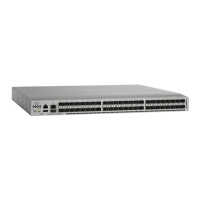





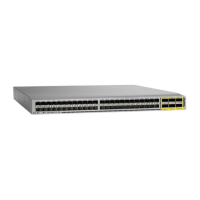
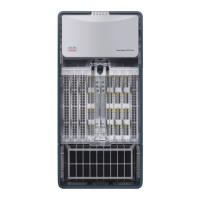

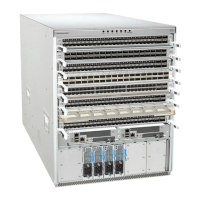
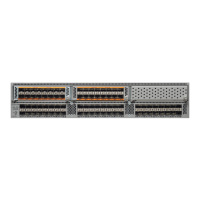
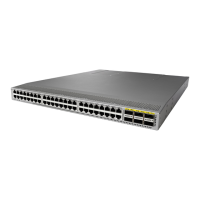
